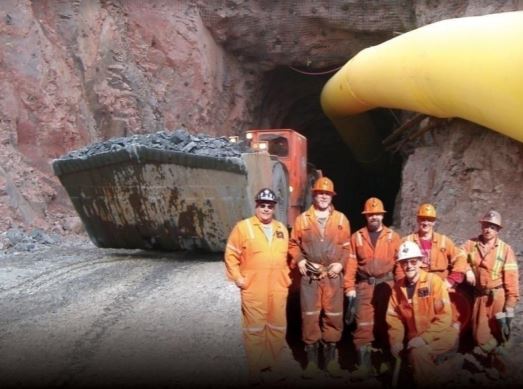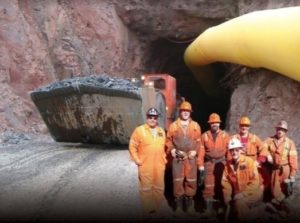Cobalt rally sparks new interest in Fortune Minerals’ NICO project

Underground test mining at the Fortune Minerals NICO Project in the Northwest Territories. Source: Fortune Minerals Ltd.
By Peter Kennedy

A recent surge in the price of cobalt has sparked renewed interest in Fortune Minerals Ltd.‘s [FT-TSX; FTMDF-OTCQX] polymetallic NICO project in the Northwest Territories.
During a telephone interview with Resource World Magazine, Fortune President and CEO Robin Goad said the company has entered into approximately 30 confidentiality agreements with potential strategic partners from diverse business sectors.
He said several of these companies are interested in purchasing metal concentrates directly from the NICO mine for treatment in their existing process facilities.
Goad said the interest in NICO can be attributed to rising price of cobalt, which is benefitting from supply concerns stemming from its role as a key ingredient used in the production of batteries.
“Roughly 53% of cobalt supply is used in rechargeable battery cathodes,” Goad said. “That includes all the major lithium battery types that are touted for future use either in electric vehicles, or electronic devices or stationary storage cells.”
According to Darton Commodities Ltd., a specialty supplier of cobalt metal products, Cobalt’s role in delivering energy efficiencies across a number of sectors has been increasing. Darton expects that cobalt use in lithium-ion batteries could be poised to grow at an average annual rate of approximately 12% from 2016 to 2022.
BMO Capital Markets recently said the cobalt rally is expected to continue, driven by growth in smart phone sales, as smartphone batteries are still the main end use market for cobalt.
Such rosy forecasts have prompted supply concerns because the vast majority of the world’s cobalt is produced as a by-product of nickel and cobalt.
Goad said his company is attracting interest because it is one of only a handful of global companies that could be producing cobalt in the near future. It could also positioning itself as a possible supplier of “ethical cobalt” to consumers seeking an alternative to the Democratic Republic of Congo, currently the source of 50% of the world’s production.
Amnesty International has warned electric car companies to seek out alternatives to the DRC, which is well known for its mineral wealth, but also civil wars and corruption.
However, as Fortune Minerals was trading at 14.5 cents on the TSX Venture Exchange, NICO will not be developed unless Goad can find someone willing to provide project financing.
The NICO deposit is located 160 km northwest of the city of Yellowknife. It contains open pit and underground proven and probable reserves of 33 million tonnes, containing 1.1 million ounces of gold, 82 million pounds of cobalt, 102 million pounds of bismuth, and 27 million pounds of copper.
At a previously planned mill throughput rate of 4,650 tonnes of ore per day, that material was expected to sustain a mining operation for 20 years. An April 2014 technical report envisaged a scenario where the site would be mined by a combination of open pit and underground methods, producing a bulk gold-cobalt-bismuth-copper-concentrate in a processing plant located at the mine site.
The bulk concentrate would be bagged at the project site, transported by road to a rail head at Hay River, NWT, and then hauled by raise to a metals processing plant in Saskatchewan, a new hydrometallurgical facility to be built by Fortune at a permitted site, approximately 26 km north of Saskatoon.
When that technical report was announced in 2014, cobalt was selling for US$16 a pound. It has since jumped US$40 a pound.
The estimated pre-production capital expenditures for the construction at NICO were estimated in the 2014 technical report at $346 million. Capital expenditures would include an additional $41.4 million for sustaining capital expenditures to be incurred throughout the life of the mine.
The added cost of the Saskatchewan processing plant was expected to push the price tag to around $600 million, Goad said during the interview.
Fortune says if it were to strike a deal with companies who are interested in purchasing metal concentrates directly from the mine site, it would enable the company to defer the Saskatchewan refinery, thus reducing the up-front capital by about 50% and mitigating risks in commissioning and downstream processing.
Although the sale of the concentrates was previously investigated by Fortune, the expanded cobalt market, strong future growth, and attractive prices have collectively made this into a potentially attractive development option to defer the significant up-front capital, the company has said.
While talks continue, Fortune has engaged Hatch Ltd., P&E Mining Consultants Inc. and Micron International Ltd. to update the 2014 NI 43-101 technical report on the NICO Project feasibility study based on current operating and capital costs, commodity prices and currency exchange rates.
The technical report is also assessing the economies of scale of a 30% expanded mill throughput rate, higher mining rate, and other mine, process and environmental improvements made to the NICO Project over the past year.
In order to allow for the flexibility of selling metal concentrates directly from the mine, Fortune has instructed Hatch to adjust the engineering design and move the bulk concentrate regrind circuit and secondary flotation concentration process back to the Northwest Territories site.
With the flexibility of proceeding with, or deferring the downstream process plant in Saskatchewan, Fortune says it would not only have the ability to reduce up-front capital costs, but also to stage the various unit operations as required to reduce commissioning risks.
